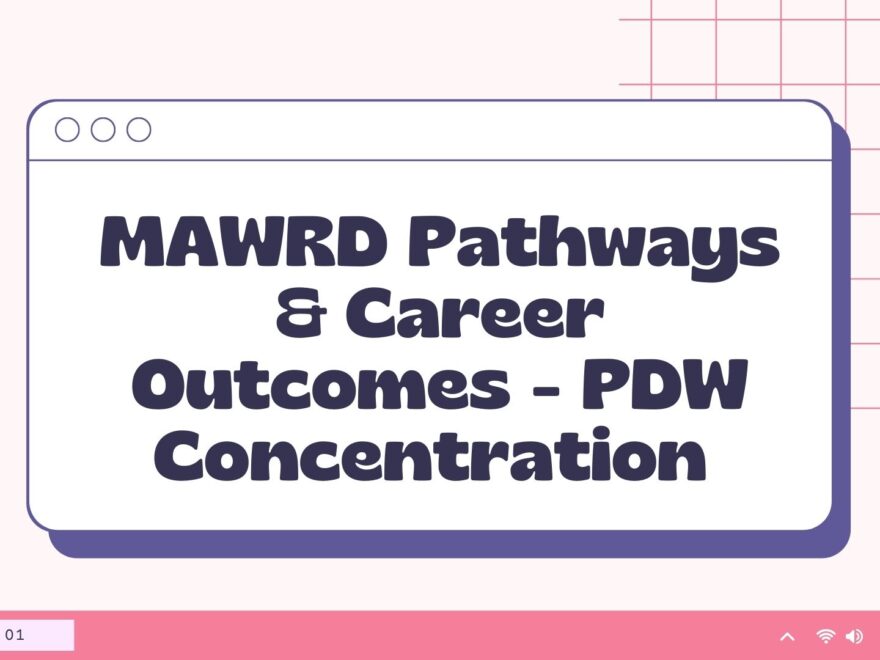The MAWRD program can be as practical as it can be theoretical, with classes ranging from teaching preparation to web content strategizing. While you may be reading Bitzner and defining rhetoric, or reading Martinez and delving into multicultural rheotrics. Partnering with non-profit organizations to aid them in grant writing or editing is also a component of many classes,and creating multimodal works that redefine what people consider as writing is included in coursework across the program.
WRD prepares writers for many jobs, but three subsets seem to stand out: teaching, technical writing, and content strategizing. These professions are not the limit of what WRD alums could do with their degree, but they are supported by the most direct pathways based on provided classes, certifications, and service-learning opportunities.
To begin, technical writing and content strategy courses can fall under the Professional and Digital Writing concentration and also lend themselves to participating in the SWAN certificate and Digital Humanities certficate. Both career paths favor academic, professional, and/or non-profit courses, and WRD offers instruction in all of the above.
Technical Writers are clear, concise, and coherent communicators who “typically develop product manuals, how-to guides, website help sections, journal articles, and other content that distills technical information” for various companies, organizations, and institutions (Linkedin). Technical writers are able to convey the information on the desired subject matter in the language of the specific industry, in a plain and easy way.
Technical writing jobs typically have similar qualifications, including (but not limited to): a Bachelor’s Degree in relevant field — WRD, English, Communications, of the specific Technical field (but advanced degree preferred); attention to detail; clear communicator; strong organizational skills; ability to multitask; and proficient in Office, Abode, XML, UI, or other specialized software.
Typical responsibilities for a technical writer include: planning, developing, writing, and revising operation manuals, procedures, product description, etc. in a multi-modal fashion; continually working with various departments to understand their purpose and documentation needs; keeping a running style guide for technical content; keeping up on deadlines for project (as you likely will have multiple going at once); having an understanding of the various audiences you will be writing for and make sure the documents fit accordingly; and continually updating documents to fit the style of the workplace.
WRD offers a few specific classes to prepare your way to a technical writing job.
For undergraduates, there is WRD 204: Technical Writing, WRD 323: Editing, and WRD 280: Writing in the Sciences. Masters students can take WRD 521: Technical Writing, WRD 523: Editing, and WRD 526: Grant & Proposal Writing.
Content Strategist or Manager is another profession that can be well represented by the professional and digital writing concentration. A successful Content Manager works with their team, as well as multiple departments to assess, “plan, and execute a content strategy that is not only engaging but also in line with the brand’s image and objectives…A Content Manager stays up-to-date on industry best practices and adjusts the content strategy as necessary. Improvements to the content strategy should also be made as the Content Manager analyzes key website and social media metrics (Indeed)”.
Content strategists positions require many of the same qualifications: Bachelor’s degree in communications, marketing, journalism, English, or related field; strong writing and speaking abilities; proficient computer skills — Microsoft Office, Adobe Suite, Google Analytics, WordPress, etc; knowledge of Search Engine Optimization (and experience with is always preferred) & keyword placement for metadata; the ability to multitask; and the ability to work on a team. All of these things are at least touched upon in Content Strategy, so none of this is out of reach.
Their daily responsibilities range widely from: managing all content creation, revision, and retention across multiple mediums and platforms; acting as editor for all content and supervisor for all content related team members (editors, social media managers, ad writers, freelance writers etc.); creating and managing the analytics of the social media platform that engages with all audiences and adjusting it according to researched trends; creating, organizing, updating, and circulating an editorial calendar for all relevant content (and enforcing it!); continually brainstorming and collaborating with all departments for any new content needs; and managing. the SEO for the company’s media in order to optimize its searchability
WRD offers numerous courses that will contribute greatly to a content management job. The undergrad classes are WRD 201: Digital Writing, WRD 202: Professional Writing for Business, WRD 202X: Professional Writing for Business (For Non-native Speakers), WRD 262: The Rhetoric of Everyday Texts, WRD 301: Workplace Writing: Theory and Practice, WRD 322: Writing and Metadata, and WRD 363: Visual Rhetoric.
The relevant Masters courses include WRD 522: Writing in the Professions, WRD 524: Document Design, WRD 525: Writing for the Web, WRD 531 Digital Storytelling, WRD 532: Content Strategy, and WRD 533: Writing Across Media.
These courses open various possibilities for where you can take your WRD degree, because electives outside of the department often fulfill student’s niche interests and goals while rounding out required hours. There are other electives, like UX design, that can also help hone all these skills. Becoming a professional and digital writer is one of the many tracks WRD can guide you on, and next week we will go over the program’s popular teaching track.
